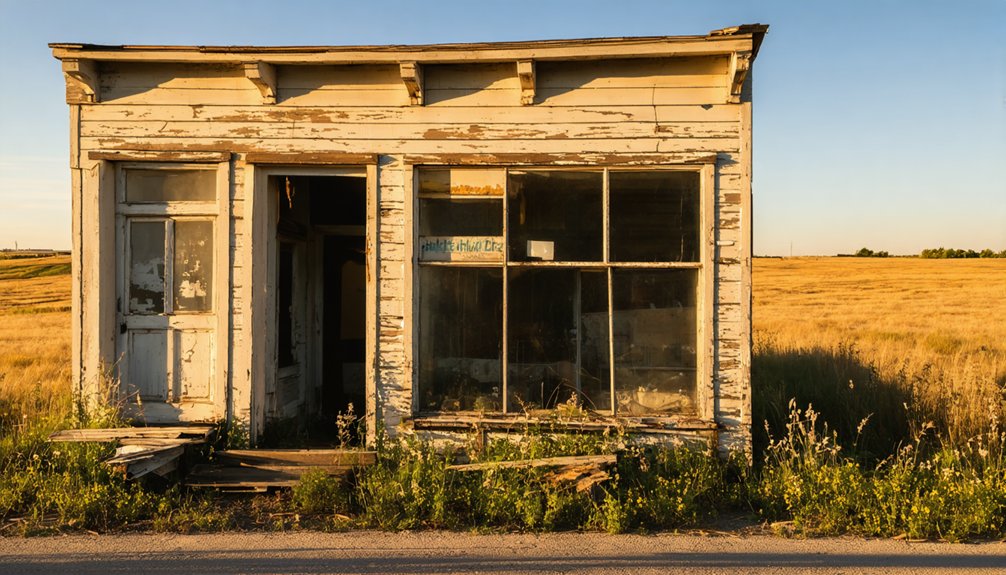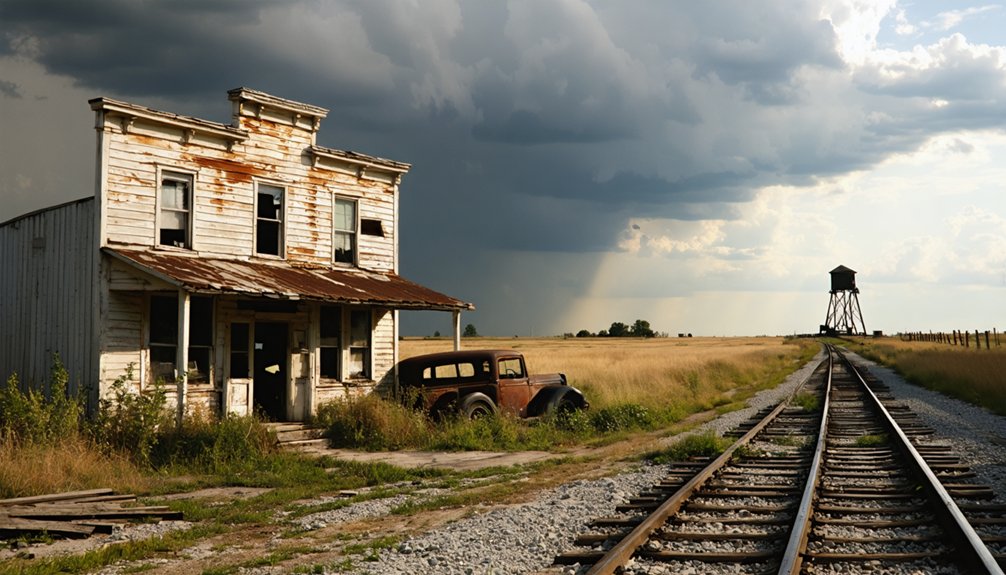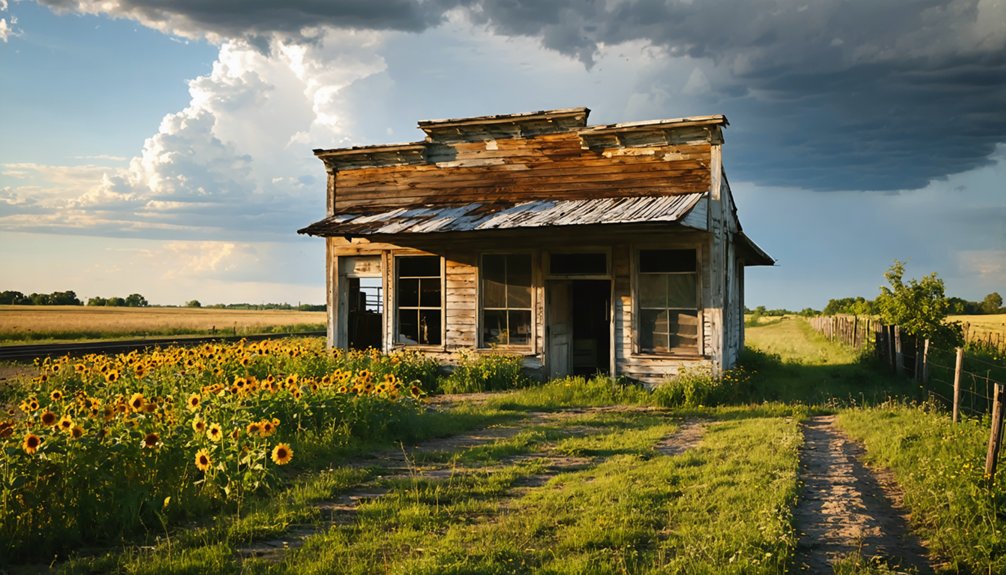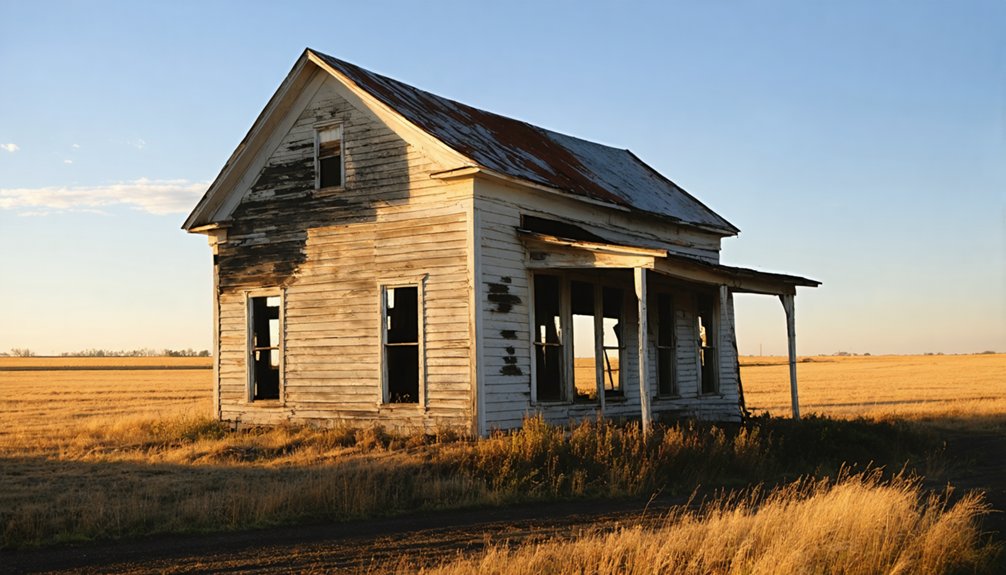In South Dakota’s early 1900s, you’ll find Firesteel’s remarkable transformation from a thriving coal mining town to an abandoned ghost town. At its peak in the 1920s, this settlement of 500 residents produced 40,000 tons of coal annually, powering the State Capitol and local schools. The town flourished with banks, stores, and a flour mill until 1969, when declining coal demand led to its downfall. Today’s crumbling structures and empty vault tell a compelling story of boom-to-bust americana.
Key Takeaways
- Firesteel was a thriving coal mining town in South Dakota that reached its peak with 500 residents and 40,000 tons of annual production.
- The town’s economy relied solely on coal mining, with operations serving major institutions including the State Capitol until declining after 1969.
- Once featuring banks, stores, and a flour mill, Firesteel became isolated due to lack of major transportation routes and economic diversification.
- The town’s decline began when coal demand decreased, forcing young residents to relocate and leading to closure of essential services.
- Today, Firesteel stands as a ghost town with abandoned structures, including its iconic bank vault, representing South Dakota’s coal mining heritage.
The Rise of a Coal Mining Powerhouse
While Native Americans may have used Firesteel’s coal deposits as early as the 1880s, the area’s transformation into South Dakota’s only coal mining powerhouse began in 1907 when Andrew Traversie and William Benoist first confirmed mining operations.
You’ll find that this initial coal discovery sparked significant commercial interest, leading Fred Hammersly and Charles Lindt to establish larger operations by 1911.
The mining techniques evolved quickly from personal-use extraction to organized commercial ventures, culminating in the formation of the Firesteel Coal Company in 1923.
Under their management, the operation expanded dramatically, employing over 60 men and reaching peak production of 40,000 tons annually.
With an estimated 137,580,000 tons of coal in the fields, Firesteel became an essential supplier for institutions across the region.
The introduction of mechanized stripping in 1929 revolutionized coal extraction efficiency when the Firesteel Coal Company brought in their first dragline.
Life During the Boom Years
During its peak years, you’d find Firesteel bustling with around 500 residents, as coal mining operations drew workers and their families to this remote South Dakota outpost.
The downtown district hummed with activity, featuring supply stores and essential services that catered to the mining community’s daily needs.
The arrival of railroad connections strengthened Firesteel’s economic foundation, enabling efficient coal transport to heat major institutions like the state capitol and regional colleges.
Mining Drives Population Growth
The discovery of rich coal deposits transformed Firesteel from a sparse settlement into a bustling mining town of 500 residents in the early 20th century.
You’d have witnessed waves of workers and their families arriving, drawn by the promise of mining employment in the region’s rich coal fields – estimated at 137 million tons. The influx reshaped community demographics, creating a youthful population as young families settled in the area. Today’s median age of 19.9 shows this demographic pattern continues. Like the Black Hills Expedition that discovered gold in 1874, these coal discoveries brought dramatic changes to Dakota Territory.
As mining operations expanded, you’d have found a diverse workforce emerging, from skilled laborers to specialists who kept the mines running.
The demands of coal production, which supplied heat to South Dakota’s state colleges and capitol building, sustained this growth. The town’s identity became inseparable from its mines, with residential development and local services springing up to support the burgeoning population.
Bustling Downtown Business District
At its peak, you’d have found Firesteel’s downtown district humming with commercial activity as merchants established essential businesses to serve the growing mining population.
Local merchants’ contributions went beyond just providing goods and services – they created a vibrant community hub where residents gathered, socialized, and supported one another through the challenges of frontier life. Many merchants used traditional flint and steel methods for lighting their shop fires before the widespread adoption of friction matches in the late 1800s.
The downtown district offered:
- Essential supplies like food, clothing, and mining tools
- Employment opportunities for local residents
- Community gathering spaces for social events and celebrations
- Basic infrastructure including roads and commercial buildings
- Cultural exchange opportunities among the diverse mining workforce
These businesses formed the economic backbone of Firesteel, fostering a strong sense of community while serving both permanent residents and transient workers during the town’s prosperous mining years.
Railroad Brings Economic Prosperity
Following Firesteel’s establishment in the 1880s, the Chicago and North Western Railroad‘s expansion through Beadle County transformed the town into a thriving economic hub.
You’d have witnessed revolutionary railroad innovations reshaping daily life, as the Dakota Central line connected Firesteel to distant markets and opportunities. Similar to the steam locomotives that powered the Black Hills railroads, these engines drove commerce and development throughout the region.
The railroad’s impact on community connectivity was profound. You’d find the depot buzzing with activity – serving as both a commercial center and social gathering spot. Like the competing Milwaukee Road in Columbia, the rail line’s presence attracted new businesses and settlers to the area.
Telegram services kept you informed of national events, while the constant flow of new settlers enriched the town’s cultural fabric.
Coal from local mines, shipped by rail to heat the state capitol and schools, drove the economy. The strategic placement of grain elevators and warehouses along rail sidings enabled you to efficiently export agricultural products, cementing Firesteel’s regional importance.
Railroad’s Role in Town Development
Originally planned to pass through Firesteel at the intersection of Firesteel Creek and the James River, railroad development took an unexpected turn when concerns about flooding prompted the Chicago, Milwaukee, and St. Paul Railroad to choose a site two-and-a-half miles west.
This decision drastically altered the region’s town formation dynamics, leading to the birth of Mitchell.
The railroad’s relocation effects reshaped the entire area:
- Firesteel’s citizens and buildings moved to the new Mitchell location
- Railroad infrastructure, including roundhouses and machine shops, established Mitchell as a hub
- Depots served as crucial communication centers for telegrams and packages
- Grain elevators and warehouses supported agricultural commerce
- The transportation network connected Mitchell to broader market opportunities
Economic Impact on South Dakota

While Firesteel’s coal mining industry once powered South Dakota’s institutions and employed hundreds, its economic influence diminished dramatically after 1969. The town’s peak population of 500 dwindled as mining operations ceased, and unlike modern tourism-driven areas like Custer County, Firesteel never achieved economic diversification beyond coal extraction.
When you compare regional economic patterns, you’ll find Firesteel’s story reflects a common theme among single-industry towns. Like the town of Camp Crook’s 300 miners, Firesteel experienced a complete economic collapse when its primary industry failed.
While South Dakota now generates $275.14 million annually from heritage tourism and historic sites, Firesteel remains largely abandoned. You won’t find significant reinvestment in the area, and agricultural activity remains sparse.
The town’s legacy serves as a stark reminder of how over-reliance on extractive industries can lead to economic collapse in rural communities.
Daily Life and Local Businesses
During Firesteel’s peak years, you’d find its Main Street bustling with a diverse mix of businesses, from the local bank with its still-standing vault to general stores, flour mills, and auto parts dealerships.
You could watch coal miners heading to and from their shifts while merchants tended to customers at meat markets, implement stores, and the town’s stockyards.
The daily rhythm of commerce intertwined with the Milwaukee Road railroad’s schedule, as trains carried both coal and commercial goods that sustained the town’s 500 residents. Like many communities across South Dakota, the introduction of truck transportation contributed to Firesteel’s eventual decline.
Much like the town of Richmond, Firesteel’s infrastructure included a bustling depot that served as a vital transportation hub for the region.
Commerce Along Main Street
As Firesteel reached its peak in the 1920s-1940s, over 500 residents sustained a vibrant commercial district along Main Street. Similar to how Rockerville’s Gaslight Restaurant remains today, these businesses were the heart of the community.
You’d find essential services clustered together, anchored by the coal industry that powered South Dakota’s growth. The Milwaukee Road railway enabled commerce to flourish, connecting Firesteel’s businesses to regional markets.
- General stores stocked daily necessities, keeping residents close to home
- Auto parts dealerships served the growing number of vehicles
- Agricultural implement businesses supported local farmers
- A flour mill processed regional grain harvests
- A bank provided financial services, its vault still standing today
The commercial services along Main Street reflected Firesteel’s dual identity as both a mining hub and farming community, though all would eventually vanish as the coal industry declined.
Work and Community Activities
The daily rhythm of Firesteel pulsed with coal mining at its core, employing several hundred miners who worked in shifts extracting high-grade coal from the region’s rich deposits.
You’d find miners heading to and from the mines while their families kept the town’s social fabric intact through community engagement at local gathering spots.
The general stores buzzed with activity as residents shopped for household goods and farming implements, while the bank handled the town’s financial matters.
Social gatherings centered around places you’d expect in a mining town – likely a bar or social hall where workers could unwind.
Between the flour mill processing local grain and auto parts dealership servicing vehicles, Firesteel’s roughly 500 residents maintained a self-sufficient working community until mining operations ceased in 1959.
The Beginning of the Decline

While Firesteel once flourished as an essential coal mining town supplying fuel to South Dakota’s colleges and state capitol, its decline began when alternative energy sources emerged in the early 20th century.
The town’s economic vulnerability became evident as coal demand decreased, triggering significant demographic shifts that would ultimately seal its fate.
- Reduced reliance on local coal undermined the town’s primary industry
- Lack of major rail lines or highway access isolated the community
- Young residents relocated to larger cities for better opportunities
- Failed attempts to diversify beyond coal mining weakened stability
- Declining population led to closure of essential services
As transportation improved and urban migration accelerated, Firesteel couldn’t sustain its population of 500.
The town’s dependence on a single industry, combined with its increasing isolation, created a downward spiral from which it couldn’t recover.
Architectural Legacy and Remnants
If you visit Firesteel today, you’ll find the bank vault standing as the most prominent reminder of this once-bustling coal mining town.
The vault’s exposed construction reveals the era’s typical building materials, including locally-sourced stone and period-appropriate industrial metals.
Through decades of abandonment, this steadfast remnant has witnessed the transformation of Firesteel from a 500-person strong community to an empty prairie dotted with scattered foundations.
Bank Vault Endures Time
Historical records provide no evidence of a surviving bank vault or banking architecture in Firesteel, South Dakota. While you might expect to find remnants of banking history in this former coal mining town of 500 residents, there’s no documentation of a dedicated bank building or vault ever existing here.
- Unlike other South Dakota ghost towns with preserved bank structures, Firesteel’s legacy centers solely on coal mining.
- No historical photographs or blueprints show banking architectural features.
- Town’s economic focus was supplying coal to colleges and the state capitol.
- If a bank operated, it would’ve been small and likely housed in a wooden structure.
- No preservation efforts or archaeological studies mention bank vault remains.
The absence of banking artifacts in historical societies and preservation records suggests Firesteel’s commercial infrastructure was modest and impermanent.
Original Building Materials Revealed
Three primary building materials shaped Firesteel’s architectural legacy: locally mined coal, regional timber, and native stone. You’ll find these materials reflected the town’s practical approach to building techniques, with coal serving as the foundation for major structures while showcasing the area’s industrial roots.
Local timber provided essential framing, flooring, and roofing elements, capitalizing on the region’s abundant forestry resources. Material sourcing remained close to home, with native stone – likely sandstone or fieldstone – forming the bedrock of foundations and walls.
While imported metal products supplied necessary hardware and reinforcements, Firesteel’s builders relied heavily on vernacular construction methods, including hand-cut joinery and mortise-and-tenon framing. The town’s utilitarian architecture emphasized function over decorative flourishes, distinguishing it from more tourist-oriented Black Hills settlements.
Structural Evolution Over Decades
When Firesteel reached its peak in the early 1900s, the town’s architectural footprint reflected its role as a thriving coal mining hub, with structures ranging from industrial facilities to commercial establishments.
You’ll find that infrastructure changes over the decades have left only sparse remnants of Firesteel’s architectural influences. The town’s evolution from bustling community to ghost town status is evident in these key structural developments:
- The Milwaukee Road branch’s rail infrastructure supported coal transport operations
- A prominent flour mill marked the town’s industrial capabilities
- Multiple general stores and auto parts businesses lined the streets
- The bank vault stands as one of the few remaining structural elements
- Commercial buildings were strategically platted around coal mining operations
The most dramatic transformation occurred as the coal industry declined, leading to widespread abandonment and demolition of the original structures.
Stories From Former Residents
Former residents’ memories paint a vivid picture of Firesteel’s bustling heyday, when the town’s population swelled beyond 500 during the peak mining years of the 1920s through 1940s.
Through oral histories, you’ll discover stories of a self-sufficient community where coal miners could find everything they needed – from general stores and auto parts to a flour mill that served the local agricultural needs.
Community memories reveal a close-knit town where the Milwaukee Railroad brought energy, connecting Firesteel’s coal operations to the rest of South Dakota.
The coal you’ll hear about heated the State Capitol and most colleges across the state.
While the town’s physical structures have largely vanished, these stories, preserved through documentaries and historical records, keep alive the spirit of South Dakota’s only coal mining town.
Geographic Significance and Location

Located at the crossroads of -98.512800 longitude and 43.808100 latitude in Aurora County, South Dakota, Firesteel stands as a tribute to the region’s rich coal mining heritage.
Nestled in Aurora County’s prairies, Firesteel marks the spot where South Dakota’s coal mining legacy once thrived.
You’ll find this historic ghost town nestled in the heart of the Great Plains, where geographic features showcase the raw beauty of prairie landscapes.
- Connected to the Milwaukee Road railway line during its heyday
- Accessible via rural roads, though off the beaten path of major highways
- Situated in a region known for its significant coal deposits
- Characterized by typical Great Plains climate with dramatic seasonal changes
- Surrounded by pastureland where mining operations once dominated
The town’s strategic location played an essential role in its success as a coal supplier to major institutions, including the state capitol, before its eventual decline in 1959.
Modern Day Ghost Town Status
The once-thriving coal mining community of Firesteel now stands as a stark reminder of South Dakota’s industrial past. Where 500 residents once lived and worked, you’ll now find abandoned structures and deteriorating infrastructure, telling the story of a town that couldn’t survive the collapse of its primary industry.
Today’s Firesteel faces significant preservation challenges as nature steadily reclaims the landscape. You’ll notice the absence of basic services and modern amenities that once supported daily life.
While community engagement efforts have sparked interest in preserving the town’s historical significance, the remote location and limited resources make conservation difficult. The ghost town serves as both a cautionary tale of economic dependence and a potential educational resource for those interested in South Dakota’s coal mining heritage.
Frequently Asked Questions
What Natural Disasters or Accidents Occurred in Firesteel’s Mining Operations?
Like untold stories buried in time, you won’t find major documented disasters in Firesteel’s mining history. No flood damage or cave-ins are officially recorded during its coal operations from 1900s to 1969.
Were There Any Famous Visitors or Notable Events in Firesteel’s History?
You won’t find records of famous visitors or notable events in Firesteel’s documented history, as it functioned primarily as a working-class coal mining town focused on daily operations and commerce.
What Happened to the Mining Equipment After the Town Was Abandoned?
You’ll find the mining equipment’s disposition varied: companies salvaged valuable machinery, while they left heavier items behind. After town abandonment, weather damage, vandalism, and scavenging claimed most remaining equipment.
Did Native American Tribes Have Any Significant Interactions With Firesteel?
You’ll find Native American interactions centered on ancestral Sioux territory, with tribal history showing the Cheyenne River Sioux used this land before, during, and after Firesteel’s brief existence.
Were There Any Schools or Churches Established During Firesteel’s Peak Years?
While education facilities and religious institutions likely existed given the town’s 500-person population, you won’t find concrete historical evidence documenting specific schools or churches during Firesteel’s peak years.
References
- https://www.youtube.com/watch?v=Glucs_Rq8Xs
- https://www.youtube.com/watch?v=KnUhRBzv8OY
- https://aberdeenmag.com/2019/01/the-ghost-towns-of-brown-county/
- https://www.youtube.com/watch?v=vukOMAHhsy8
- https://en.wikipedia.org/wiki/List_of_ghost_towns_in_South_Dakota
- https://en.wikipedia.org/wiki/Firesteel
- https://history.sd.gov/docs/Mining.pdf
- https://history.sd.gov/museum/docs/Mining.pdf
- https://www.hmdb.org/m.asp?m=161846
- https://pubs.usgs.gov/bul/1252c/report.pdf



